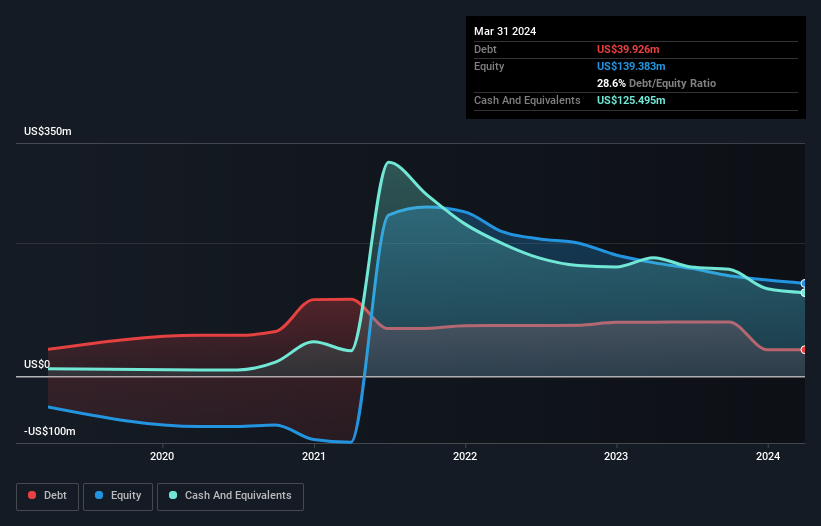The external fund manager backed by Berkshire Hathaway's Charlie Munger, Li Lu, makes no bones about it when he says 'The biggest investment risk is not the volatility of prices, but whether you will suffer a permanent loss of capital.' It's only natural to consider a company's balance sheet when you examine how risky it is, since debt is often involved when a business collapses. We note that BARK, Inc. (NYSE:BARK) does have debt on its balance sheet. But the real question is whether this debt is making the company risky.
What Risk Does Debt Bring?
Generally speaking, debt only becomes a real problem when a company can't easily pay it off, either by raising capital or with its own cash flow. In the worst case scenario, a company can go bankrupt if it cannot pay its creditors. However, a more common (but still painful) scenario is that it has to raise new equity capital at a low price, thus permanently diluting shareholders. Having said that, the most common situation is where a company manages its debt reasonably well - and to its own advantage. When we think about a company's use of debt, we first look at cash and debt together.
See our latest analysis for BARK
How Much Debt Does BARK Carry?
The image below, which you can click on for greater detail, shows that BARK had debt of US$39.9m at the end of March 2024, a reduction from US$81.2m over a year. However, it does have US$125.5m in cash offsetting this, leading to net cash of US$85.6m.

How Strong Is BARK's Balance Sheet?
Zooming in on the latest balance sheet data, we can see that BARK had liabilities of US$75.5m due within 12 months and liabilities of US$83.7m due beyond that. Offsetting this, it had US$125.5m in cash and US$7.70m in receivables that were due within 12 months. So its liabilities outweigh the sum of its cash and (near-term) receivables by US$26.0m.
Of course, BARK has a market capitalization of US$286.3m, so these liabilities are probably manageable. However, we do think it is worth keeping an eye on its balance sheet strength, as it may change over time. Despite its noteworthy liabilities, BARK boasts net cash, so it's fair to say it does not have a heavy debt load! There's no doubt that we learn most about debt from the balance sheet. But it is future earnings, more than anything, that will determine BARK's ability to maintain a healthy balance sheet going forward. So if you're focused on the future you can check out this free report showing analyst profit forecasts.
Over 12 months, BARK made a loss at the EBIT level, and saw its revenue drop to US$490m, which is a fall of 8.4%. We would much prefer see growth.
So How Risky Is BARK?
By their very nature companies that are losing money are more risky than those with a long history of profitability. And we do note that BARK had an earnings before interest and tax (EBIT) loss, over the last year. Indeed, in that time it burnt through US$2.8m of cash and made a loss of US$37m. But the saving grace is the US$85.6m on the balance sheet. That kitty means the company can keep spending for growth for at least two years, at current rates. Overall, we'd say the stock is a bit risky, and we're usually very cautious until we see positive free cash flow. There's no doubt that we learn most about debt from the balance sheet. However, not all investment risk resides within the balance sheet - far from it. Case in point: We've spotted 2 warning signs for BARK you should be aware of.
Of course, if you're the type of investor who prefers buying stocks without the burden of debt, then don't hesitate to discover our exclusive list of net cash growth stocks, today.
Valuation is complex, but we're here to simplify it.
Discover if BARK might be undervalued or overvalued with our detailed analysis, featuring fair value estimates, potential risks, dividends, insider trades, and its financial condition.
Access Free AnalysisHave feedback on this article? Concerned about the content? Get in touch with us directly. Alternatively, email editorial-team (at) simplywallst.com.
This article by Simply Wall St is general in nature. We provide commentary based on historical data and analyst forecasts only using an unbiased methodology and our articles are not intended to be financial advice. It does not constitute a recommendation to buy or sell any stock, and does not take account of your objectives, or your financial situation. We aim to bring you long-term focused analysis driven by fundamental data. Note that our analysis may not factor in the latest price-sensitive company announcements or qualitative material. Simply Wall St has no position in any stocks mentioned.
Have feedback on this article? Concerned about the content? Get in touch with us directly. Alternatively, email editorial-team@simplywallst.com
About NYSE:BARK
BARK
A dog-centric company, provides products, services, and content for dogs.
Undervalued with excellent balance sheet.
Similar Companies
Market Insights
Community Narratives



